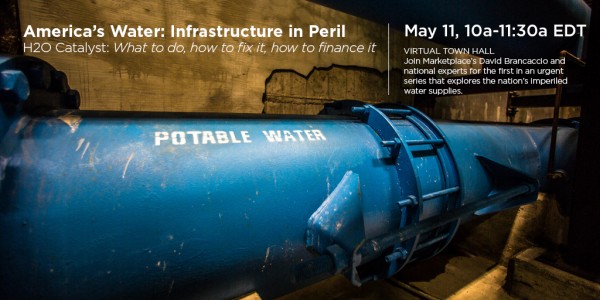Federal Water Tap, May 2: Senate Committee Passes $US 9 Billion Water Development Act
The Rundown
Broad, bipartisan bill offers money for Flint, ports, levees and clears its first legislative hurdle. Meanwhile, a Great Lakes funding bill passes the House. The EPA begins developing a national drinking water strategy. The Obama administration, by releasing or beginning several reports, makes good on its promise to investigate water technology. An EPA advisory board reports on water infrastructure financing. The White House declares flood and drought disasters. And finally, this week, Obama visits Flint, Michigan.
“Look, 19-1. Nothing happens here 19-1. Even a resolution on Mother’s Day, somebody would say, ‘Well my mother was not nice to me today; I’m not going for it.’” — Sen. Barbara Boxer (D-CA), enthusiastic after the Environment and Public Works committee passed a water resources spending bill by an overwhelming margin.
By the Numbers
$US 220 million: Funding for Flint and other cities to replace lead pipes and for children’s health programs. The funding, which Senate Democrats have tried to pass for months, was attached to the Water Resources Development Act that was approved by committee.
$US 1.4 billion: Grants for water infrastructure for rural or poor communities, included in the Water Resources Development Act.
30 percent: Share of fish samples in the American West and Canada that had mercury concentrations in muscle tissue above the U.S. Environmental Protection Agency standard. (U.S. Geological Survey)
47 percent: Share of U.S. water utilities that conduct regular leak detection surveys. (Government Accountability Office)
News Briefs
Water Resources Development Act
The Senate Committee on Environment and Public Works passed a $US 9.4 billion Water Resources Development Act, which is a primary funding vehicle for U.S. Army Corps of Engineers projects — ports, levees, locks, and dams. Being Washington, much, much more is included.
The act is typically renewed every two years, a schedule that Sen. Jim Inhofe (R-OK), the committee chair, said earlier this year that he would like to return to.
The 271-page bill includes $US 220 million for lead-related infrastructure and health programs, $US 530 million to repair dams that would kill people if they collapsed, $US 100 million for Chesapeake Bay oyster restoration, more expansive partnerships for combating toxic dust at California’s Salton Sea, hundreds of million for big-ticket restorations of the Everglades and the Los Angeles River, and reviews of reservoir operations to incorporate the latest forecasting tools and climate knowledge.
The bill removes the “pilot” tag for WIFIA, a water infrastructure financing program that seeks to attract private capital. It also includes provisions to allow cities to complete an “integrated” plan for complying with federal water regulations, the goal of which is, basically, to kill multiple birds with one stone and to do so more cheaply than in a piecemeal fashion.
The bill also includes a “sense of the Senate” statement that the federal loan funds for drinking water and clean water should be “robust.”
National Drinking Water Plan
That’s what the U.S. Environmental Protection Agency is developing.
In a blog post, Joel Beauvais, the head of the EPA water office, said the agency will begin a series of consultations with local governments, regulators, utilities, and health and environmental groups to discuss safe drinking water. The plan will be released by the end of the year.
The plan will address four areas:
- Implementing the Safe Drinking Water Act
- Funding for poor and rural areas
- Protecting against lead
- Prioritizing unregulated contaminants that pose a health risk
Great Lakes Bill Passes
The House passed the Great Lakes Restoration Initiative Act, a bill that authorizes $US 300 million per year for the next five years to help make the Great Lakes’ ecology whole again. The initiative, which began in the early years of the Obama administration, has been a magnet for ecosystem funding in the lakes region.
Drought and Flood Disasters
President Obama declared two federal disasters: a flood disaster for four Texas counties in the Houston metro area, and a drought disaster in the Marshall Islands, a sovereign nation that receives financial help from the United States. The designation allows for federal funds to be used for emergency aid.
Studies and Reports
Technology Solutions for Drinking Water
Utilities that manage wastewater or stormwater in addition to drinking water are more likely to treat alternative sources of water for drinking, according to a survey of 832 utilities by the Government Accountability Office.
The report, which summarizes the availability of leak-reducing technologies (to curb demand) and water-treatment technologies (to produce more supply), shows that unifying the fragmented nature of the water field produces more holistic management.
The report was requested by four Democrats: Sen. Edward Markey of Massaschusetts, Rep. Peter DeFazio of Oregon, Rep. Raul Grijalva of Arizona, and Rep. Alan Lowenthal of California.
Financing Water Infrastructure Reports
The Environmental Financial Advisory Board helps the EPA navigate the dollars and cents questions. The board recently released four reports on aspects of water utility finance:
- funding stormwater management
- helping small water systems become financially sustainable
- addressing water affordability for poor households
- funding technical assessments — cost-benefit analyses, and other evaluations that take place before a project breaks ground.
Burning Sewage
The EPA finalized a federal plan for reducing hazardous emissions from facilities that burn sewage sludge. The rules cover existing facilities in the 18 states that do not have a state planning process for such activities. The rules are designed to cut emissions of sulfur dioxide, particulate matter, and other air pollutants.
On the Radar
Obama to Flint
On May 4, President Obama will visit Flint, Michigan, to hear about the federal efforts to clean up the mess from a lead scandal that touched every level of government, from the local water utility to the EPA.
It is the third time in just over two years that the president has scheduled a visit around water. In September 2015, he traveled to Alaska, to see the state’s shrinking glaciers. In February 2014, he visited farm fields in California’s San Joaquin alley, as the drought was strengthening.
Drinking Water Technology Report
The President’s Council of Advisors on Science and Technology, which consults with the administration on matters of geekery, will meet on May 20, in Washington, D.C. The council will begin a new study on technology for drinking water safety. The study will address monitoring and detection of contaminants and communication of risks to the public.
Norfolk Flooding Study
How to keep one of the U.S. cities most vulnerable to sea-level rise from flooding? The U.S. Army Corps of Engineers will study a number of options to reduce flood risk in Norfolk, Virginia, a coastal city that is home to Naval Station Norfolk, commonly described as the world’s largest naval base.
Federal Water Tap is a weekly digest spotting trends in U.S. government water policy. To get more water news, follow Circle of Blue on Twitter and sign up for our newsletter.
Brett writes about agriculture, energy, infrastructure, and the politics and economics of water in the United States. He also writes the Federal Water Tap, Circle of Blue’s weekly digest of U.S. government water news. He is the winner of two Society of Environmental Journalists reporting awards, one of the top honors in American environmental journalism: first place for explanatory reporting for a series on septic system pollution in the United States(2016) and third place for beat reporting in a small market (2014). He received the Sierra Club’s Distinguished Service Award in 2018. Brett lives in Seattle, where he hikes the mountains and bakes pies. Contact Brett Walton







Leave a Reply
Want to join the discussion?Feel free to contribute!